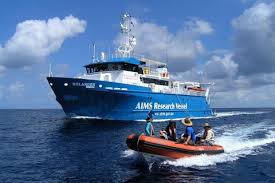Over a period of four years scientists from AIMS, working in partnership with Geoscience Australia and the University of Western Australia, uncovered a rich physical landscape and a vast oasis of life in the Oceanic Shoals Commonwealth Marine Reserve (CMR).
Building on the knowledge of two previous surveys (2009 & 2010), scientists undertook a 25-day voyage on the RV Solander to more closely investigate the western part of this CMR. The objectives of this voyage were to collect information to generate high-resolution seabed maps and to gain a more complete understanding of the biology supported by the unique physical features of the region.
AIMS staff and their collaborators, research fleet and observational equipment such as multi-beam sonar and baited video stations provided the expert capability to undertake the groundbreaking voyage.
The survey revealed the western Oceanic Shoals are biodiversity 'hotspots', being home to:
- A wide range of pelagic animals including 11 shark species, black marlin, barracuda, Olive Ridley turtle, sea snakes and orca.
- A rich diversity of marine sponges – at least 350 species, including 29 new to science and as many as 900 sponge species in total as indicated by statistical modelling.
- Four species of hard coral listed by the IUCN as “Vulnerable or Near Threatened” and one listed as “Endangered”.
- A diverse range of sediment dwelling animals with 266 species collected, including newly discovered species of sea spider, squat lobster, and worm.
Voyage observations and collections increased the identified biodiversity values of the Oceanic Shoals CMR. Program outcomes confirmed the importance of this area in representing the biodiversity of the region. This information will contribute to the effective management of the region’s biodiversity, ecosystem function and integrity into the future.
Funding for this research was made possible through the Australian Government’s National Environmental Research Program, administered by the Department of the Environment.
For further information and to obtain a PDF copy of the brochure "Exploring Oceanic Shoals Commonwealth Marine Researve" click here.



